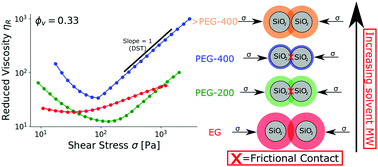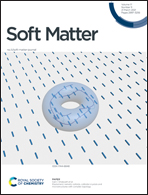The role of solvent molecular weight in shear thickening and shear jamming†
Abstract
The application of stress can drive a dense suspension into a regime of highly non-Newtonian response, characterized by discontinuous shear thickening (DST) and potentially shear jamming (SJ), due to the formation of a frictionally stabilized contact network. Investigating how the molecular weight of the suspending solvent affects the frictional particle–particle interactions, we report on experiments with suspensions of fumed silica particles in polyethylene glycol (PEG). Focusing on the monomer-to-oligomer limit, with n = 1 to 8 ethylene oxide repeat units, we find that increasing n enhances shear thickening under steady-state shear and even elicits rapidly propagating shear jamming fronts, as assessed by high-speed ultrasound imaging of impact experiments. We associate this behavior with a weakening of the solvation layers surrounding the particles as n is increased, which thereby facilitates the formation of frictional contacts. We argue that for n larger than the monomer-to-oligomer limit the trend reverses and frictional interactions are diminished, as observed in prior experiments. This reversal occurs because the polymeric solvent transitions from being enthalpically bound to entropically bound to the particle surfaces, which strengthens solvation layers.



 Please wait while we load your content...
Please wait while we load your content...